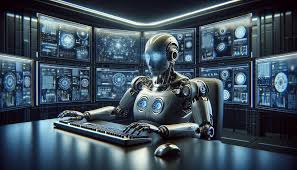Artificial Intelligence (AI) has emerged as a transformative technology across various industries, and its impact on robotics is particularly profound. Modern robots are no longer just mechanical arms or automated machines designed for simple, repetitive tasks. Thanks to the integration of AI, robots are becoming more intelligent, adaptable, and capable of performing complex tasks that were once reserved for humans. From autonomous vehicles to robots that assist in surgery or perform delicate tasks in hazardous environments, AI is enhancing the capabilities of robots and pushing the boundaries of what they can achieve.
In this article, we will explore how AI is advancing the field of robotics, the key innovations driving these improvements, and how AI-powered robots are changing industries such as healthcare, manufacturing, and even space exploration.
What is Artificial Intelligence in Robotics?
Artificial Intelligence in robotics refers to the use of algorithms, machine learning, and other cognitive technologies to enable robots to perform tasks that typically require human intelligence. These include tasks such as decision-making, pattern recognition, learning from experience, and problem-solving. In simple terms, AI gives robots the ability to “think” and “learn,” enabling them to adapt to new situations, make real-time decisions, and improve their performance over time.
There are different aspects of AI that contribute to enhancing a robot’s capabilities, including:
- Machine Learning (ML): Machine learning algorithms allow robots to improve their performance by analyzing large datasets, recognizing patterns, and making predictions. Over time, these algorithms can help robots perform more efficiently, whether it’s navigating a new environment or optimizing a production process.
- Computer Vision: This technology allows robots to “see” and interpret the world around them by processing visual data. Using AI, robots can recognize objects, track movements, and navigate complex environments with greater precision.
- Natural Language Processing (NLP): NLP enables robots to understand and respond to human speech, making human-robot interaction more intuitive. This capability is vital for robots designed to assist in customer service, healthcare, and various other fields.
- Reinforcement Learning: This technique allows robots to learn by interacting with their environment and receiving feedback, rewarding positive actions and penalizing mistakes. This helps robots become more autonomous and efficient in completing tasks over time.
Key AI Innovations Enhancing Robot Capabilities
The capabilities of modern robots have been vastly improved by a combination of AI-driven innovations. Some of the most significant advancements in AI for robotics include:
1. Autonomy and Decision-Making
AI enables robots to operate autonomously, making real-time decisions without human intervention. In industrial settings, autonomous robots are used for tasks like material handling, inventory management, and assembly line automation. They can assess their surroundings, evaluate different actions, and choose the most appropriate course of action based on their programmed objectives and environmental data.
For example, autonomous mobile robots (AMRs) can navigate factory floors and warehouses, avoiding obstacles and choosing the most efficient route to deliver materials or parts. The use of AI-powered decision-making systems has drastically increased the efficiency of operations in various sectors by reducing the need for human oversight and intervention.
2. Enhanced Precision and Dexterity
AI has enabled robots to perform tasks with much greater precision and dexterity than earlier generations of robots. This is especially evident in fields like healthcare, where robots are now capable of performing highly delicate surgeries.
For instance, robotic surgical assistants such as the da Vinci Surgical System leverage AI to enhance the surgeon’s ability to operate with increased precision, offering greater control during minimally invasive procedures. AI algorithms allow these robots to analyze real-time data from sensors, helping doctors perform complex procedures with smaller incisions, less tissue damage, and faster recovery times.
In manufacturing, AI-enhanced robots are being used for quality control, inspection, and fine assembly tasks. These robots can recognize minute defects or variations in parts and make real-time adjustments during production.
3. Improved Interaction with Humans
Robots are increasingly being designed to collaborate with humans in various settings. AI is playing a pivotal role in making robots safer and more effective in human-robot collaboration (cobots). These robots can sense human presence, predict their intentions, and adjust their behavior to work alongside people without compromising safety.
AI-powered robots with computer vision and machine learning can identify and predict human movements, making them much more adaptable in environments where human interaction is essential. This technology is useful in environments like factories, warehouses, and hospitals, where robots need to navigate spaces filled with humans while performing tasks.
For example, AI-driven collaborative robots are now assisting assembly line workers by handling dangerous or repetitive tasks, while the human workers focus on tasks that require higher levels of skill and decision-making. This symbiotic relationship improves productivity, reduces human injury, and increases overall efficiency.
4. Adaptability and Learning Capabilities
One of the most exciting aspects of AI in robotics is a robot’s ability to learn from its environment and experiences. With the help of machine learning, robots can continuously improve their performance based on feedback and new data.
In environments such as warehouses, robots can learn to adapt to changing layouts, new obstacles, and variations in tasks. Over time, they can optimize their operations by learning the most efficient routes for material handling, inventory picking, or delivery. In some cases, robots can even learn new skills on their own, becoming more versatile and efficient over time.
AI-driven robots are also becoming better at understanding complex tasks that require flexibility, such as assembling products that change frequently or responding to unexpected issues in real-time.
5. AI-Powered Speech and Language Processing
Natural Language Processing (NLP) is an area of AI that enables robots to understand and interpret human language. Robots with NLP capabilities can understand commands, respond to questions, and engage in basic conversations with humans.
This is a game-changer for industries where communication is essential. For example, service robots in healthcare facilities can assist patients with information, reminders, or even basic interactions. Robots equipped with NLP can also help in customer service roles, where they can answer frequently asked questions, process requests, and handle inquiries in a human-like manner.
In customer-facing environments, robots equipped with speech recognition and NLP allow for more seamless, intuitive human-robot interactions. Whether it’s in hospitality, retail, or healthcare, these robots are becoming increasingly adept at understanding complex verbal commands and providing meaningful responses.
6. Robots in Hazardous and Remote Environments
AI-powered robots are also making great strides in environments that are too dangerous or inaccessible for humans. Robots can now be deployed in disaster-stricken areas, deep-sea exploration, and even outer space, where human intervention is limited or impossible.
In situations like search-and-rescue missions after earthquakes or natural disasters, robots equipped with AI can navigate hazardous environments, locate survivors, and even perform basic medical assistance. These robots use AI algorithms to analyze environmental data and make real-time decisions that maximize their chances of success in dangerous and unpredictable situations.
Similarly, space agencies like NASA have developed AI-powered robots that can explore planets, moons, and other celestial bodies. These robots can gather data, analyze their surroundings, and carry out scientific experiments autonomously, providing valuable insights without the need for human astronauts to be physically present.
Applications of AI in Robotics Across Industries
1. Healthcare and Medicine
AI-powered robots are revolutionizing healthcare by assisting in surgery, providing patient care, and enhancing diagnostic capabilities. From robotic surgical assistants to rehabilitation robots, AI is improving the precision, efficiency, and outcomes of medical procedures. Robots can now perform minimally invasive surgeries, assist elderly patients with mobility, and even help with physical therapy, improving the quality of patient care.
2. Manufacturing and Automation
In manufacturing, robots have become an essential part of the production line. AI-driven robots are used for tasks such as assembly, welding, packaging, and quality control. These robots are designed to work autonomously or in collaboration with human workers to increase productivity, reduce errors, and improve overall manufacturing efficiency.
3. Agriculture
In agriculture, robots powered by AI are used to automate tasks such as planting, harvesting, and monitoring crop health. AI enables these robots to identify and respond to changes in soil conditions, weather patterns, and plant health, helping farmers optimize their yields and reduce waste.
4. Logistics and Delivery
AI-powered robots and drones are transforming logistics and delivery by automating the movement of goods. Autonomous delivery robots, for instance, are being used to transport packages in urban areas, reducing delivery times and costs. AI also allows robots to optimize delivery routes, making the entire process more efficient.
5. Exploration and Disaster Relief
AI-driven robots are used in remote and hazardous environments, such as deep-sea exploration, space missions, and disaster relief efforts. These robots can gather critical data, perform search-and-rescue operations, and assist in rebuilding efforts in the aftermath of natural disasters.
The Future of AI and Robotics
As AI continues to evolve, the capabilities of robots will only improve. The integration of advanced machine learning, computer vision, and cognitive technologies will enable robots to perform even more complex and creative tasks. In the future, robots may possess the ability to think abstractly, make ethical decisions, and collaborate with humans in more meaningful ways.
Furthermore, as AI and robotics continue to develop, we can expect new applications in industries such as education, entertainment, and even personal assistance. Robots with emotional intelligence could revolutionize customer service, and AI-powered personal assistants might become as common as smartphones.
Conclusion
Artificial intelligence is fundamentally transforming the capabilities of modern robots, enabling them to perform tasks with greater precision, autonomy, and adaptability than ever before. From healthcare and manufacturing to space exploration and disaster relief, AI-powered robots are changing the way industries operate, improving safety, efficiency, and overall performance. As AI and robotics continue to advance, the possibilities for their application are virtually limitless, and we can expect to see robots playing an increasingly vital role in our daily lives and the global economy.

